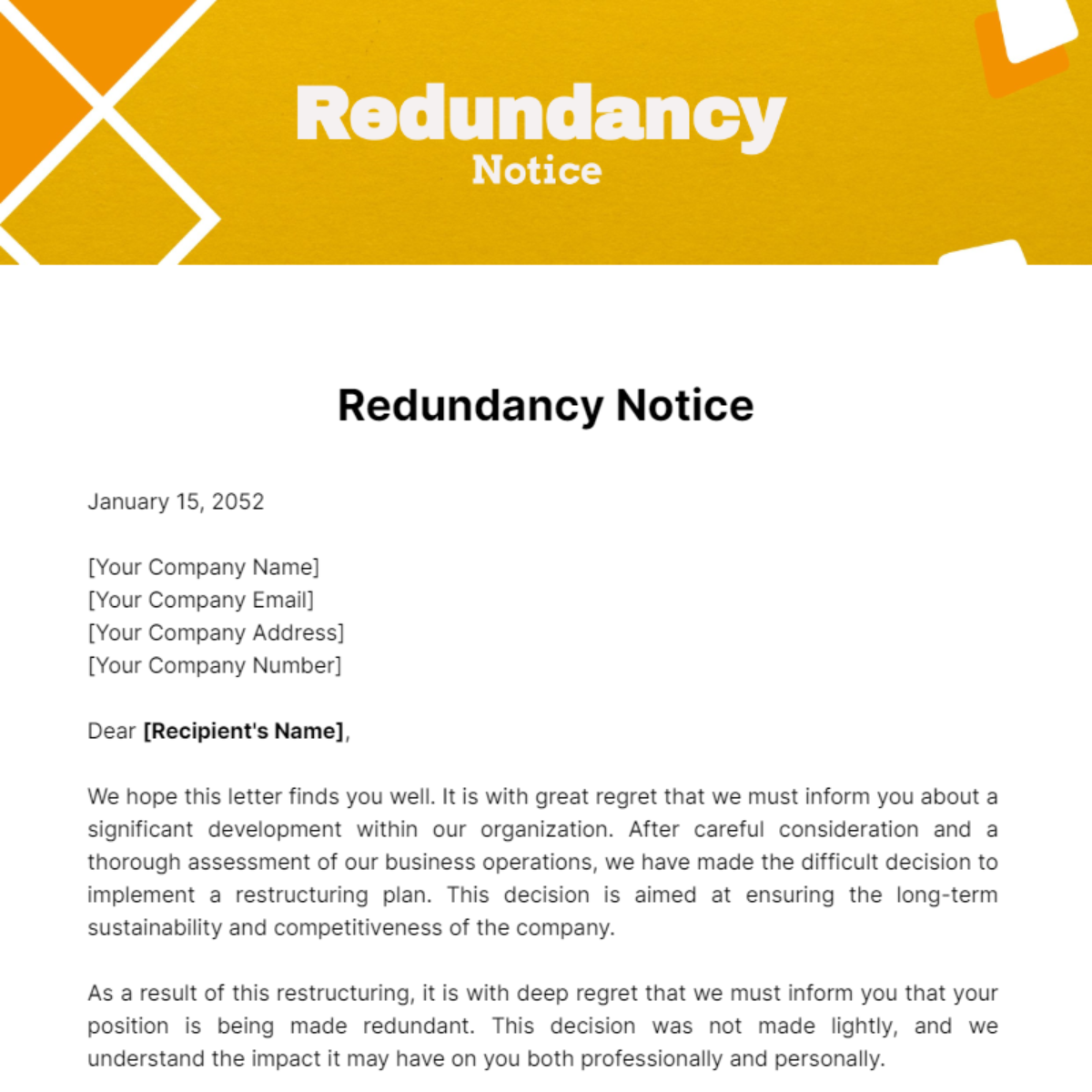Who Pays Redundancy Money? Recognizing Employer Obligations in the UK
Who Pays Redundancy Money? Recognizing Employer Obligations in the UK
Blog Article
Discovering the Operational Dynamics of Firm Redundancy and Its Long-Term Sustainability

Redundancy Strategies for Service Continuity
In order to ensure nonstop operations, organizations have to execute reliable redundancy strategies for business continuity. Redundancy in this context describes the duplication of vital parts or features within a system to reduce the influence of potential failures. By integrating redundancy approaches, organizations can improve their strength versus disruptions created by various factors such as all-natural calamities, tools failings, or cyber-attacks.
One usual redundancy technique is the application of back-up systems and information storage space remedies. This entails creating duplicates of vital information and systems that can be turned on in instance of a key system failing. Additionally, companies can develop repetitive interaction channels and source of power to maintain connection and procedures throughout unexpected events.
Additionally, cross-training workers to do several functions within the business can serve as a useful redundancy technique. This makes sure that necessary jobs can still be performed also if key personnel are unavailable due to illness or other reasons. On the whole, efficient redundancy methods are essential for companies to support operational continuity and decrease the impact of prospective disturbances.
Effect of Redundancy on Organizational Durability
Provided the crucial duty redundancy methods play in making sure service continuity, discovering the influence of redundancy on organizational resilience comes to be vital for recognizing the holistic functional dynamics of a business. Organizational durability refers to an entity's capability to adapt to interruptions, recover from troubles, and transform when essential while preserving core features. Redundancy, when tactically carried out, can significantly add to boosting an organization's strength in the face of unanticipated challenges. By having backup systems, employees, or processes in location, firms can better stand up to shocks and proceed operations with very little disturbance.
Furthermore, redundancy can boost staff member spirits and self-confidence, knowing that there are contingency plans in position to attend to unpredicted circumstances. This sense of protection can lead to enhanced productivity and a much more favorable job setting. Furthermore, redundancy can cultivate advancement and creative thinking within a company as workers really feel equipped to take calculated risks, knowing that there is a safety web to sustain them in situation of failure. In general, the impact of redundancy on business strength is profound, shaping the long-term sustainability and success of a firm.
Balancing Performance and Adaptability in Redundancy
Accomplishing a harmonious equilibrium in between functional efficiency and flexible adaptability is an essential difficulty in the strategic release of redundancy within organizations. Efficient procedures are crucial for preserving productivity and cost-effectiveness, ensuring that sources are used optimally. Nevertheless, excessive focus on effectiveness alone can bring about rigidness, making it tough for organizations to adjust to unexpected adjustments or difficulties. On the various other hand, versatility enables organizations to react nimbly to evolving circumstances, promoting innovation and strength. Yet, way too much adaptability without a solid functional structure can result in ineffectiveness and incongruity.
To balance efficiency and versatility in redundancy preparation, companies need to carefully evaluate their operational requirements, market characteristics, and calculated objectives. Implementing lean methods can improve effectiveness by removing and enhancing procedures waste, while cultivating a society of flexibility and continual renovation can enhance redundancy if company goes bust adaptability. Additionally, purchasing cross-training programs and robust communication channels can help cultivate a versatile workforce efficient in dealing with diverse tasks throughout durations of change. Inevitably, locating the appropriate stability in between effectiveness and versatility is crucial for building a lasting and durable company despite unpredictability.
Long-Term Sustainability Via Redundancy Planning
To make sure enduring feasibility and stability, companies must strategically straighten their redundancy planning with long-term sustainability goals, consequently harmonizing functional effectiveness with adaptive flexibility. Business must view redundancy not as a responsive solution Full Article to prompt issues yet as an aggressive strategy for long-term success.

Proactive Actions for Lasting Firm Procedures
How can companies proactively improve their operational sustainability for long-lasting success? Carrying out aggressive measures is vital for business aiming to make sure lasting operations.
Moreover, promoting a culture of continuous improvement and understanding within the organization can enhance flexibility to transforming market problems and client demands. Encouraging staff member participation in decision-making procedures and offering opportunities for specialist growth can improve morale, performance, and total performance. Establishing clear objectives, monitoring vital efficiency signs, and regularly reviewing progression are important components of positive sustainability management.
Collaborating with distributors, clients, and various other stakeholders to advertise lasting methods throughout the supply chain can create a surge effect of favorable effect - redundancy pay if company goes bust. By taking aggressive steps in the direction of functional sustainability, companies can construct strength, drive innovation, and safeguard their More Info long-term success in an ever-evolving organization landscape
Verdict

In the world of business management, the calculated implementation of company redundancy stands as a critical yet detailed method that necessitates a fragile balance between functional effectiveness and long-term stability. By exploring the functional characteristics that underpin company redundancy and reviewing its wider effects for organizational strength and flexibility, a nuanced understanding of exactly how redundancy approaches can shape the future trajectory of a firm begins to unravel.Provided the crucial duty redundancy techniques play in making certain company connection, exploring the impact of redundancy on organizational durability becomes essential for recognizing the holistic operational characteristics of a firm. In general, the influence of redundancy on business resilience is profound, forming the lasting sustainability and success of a company.
In final thought, recognizing the functional dynamics of company redundancy is vital for ensuring long-term sustainability.
Report this page